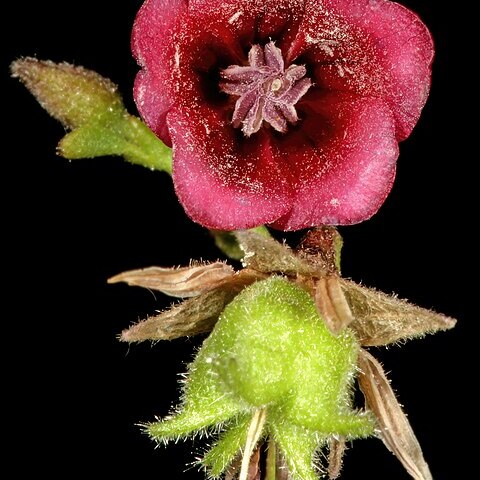Suffrutex, 20-40 cm tall, usually a rounded bush, with wiry stems and branches, young branchlets sparsely stellate-pubescent with short hairs, glabrescent, usually metallic coloured and flexuose, armed with persistent indurated spine-like peduncles. Stipules 1-2.5 mm long, rather thick and sometimes hooked, stellate-pubescent and with gland-tipped hairs, usually a few pointed hairs at apex, persistent. Leaves petiolate; blade oblong-cuneate to narrowly so, coarsely toothed in upper half or at broad apex only, or elliptic and entire (both shapes often on the same plant), 3-20 mm long, 2.5-7 mm broad, minutely papillate and stellate-pubescent on both surfaces, usually sparsely so, hairs short from a central scale, radiating and appressed to surface of the leaf; petiole 2-5 mm long, sparsely stellate-pubescent and with a few additional glandular hairs or papillae. Inflorescence of 1-flowered, axillary cymes; peduncles at first short, about 2-4 mm long, persistent, glabrescent, becoming indurated and elongating to about 8 mm, rarely longer, more or less patently spreading, appearing spiny but apex blunt; pedicles about 2-5 mm long, nodding, stellate-pubescent, deciduous. Calyx from about 5 mm to 7 mm long, lobed to just beyond middle, minutely glandular and laxly stellate-pubescent outside, lobes sparsely appressed hairy on inner face. Petals “wine-red”, “purple-mauve”, “rose-red”, “rose-pink”, “brick-red”, oblong-cuneate, 7-10 mm long, margin inrolled on claw only, apparently glabrous on inner face (or reddish papillae in a patch). Stamens with narrowly obovate, hyaline filaments, joined at base, free portion 2-3.5 mm long, pubescent on shoulders which are only slightly wider than the overlapping anther bases; anthers 4-5 mm long, ciliate. Ovary stipitate, 2.5-3.5 mm long, crowned by 10 erect, 1.5 mm long horns, glandular but with setae along sutures and on horns; styles filiform, erect, cohering. Capsule up to 1 cm long, papillose between sutures, stellate with long hairs or setose on sutures; horns ultimately divergent and recurved, up to 8 mm long, pilose; seeds about 7 developed in each cell.
More
Spinescent, gnarled shrublet, up to 400 mm tall, with whitish grey branches. Leaves obovate, slightly toothed. Flowers solitary in axils, dark pink to red, bell-shaped, peduncles stiff and becoming woody and thorn-like. Capsule horned. Mainly Aug.-Sept., but also after rain.
Spinescent, twiggy shrublet to 40 cm, with wiry branches. Leaves obovate, slightly toothed. Flowers solitary in axils, dark pink to red, bell-shaped, peduncles stiff and becoming woody and thorn-like. Capsules horned.

